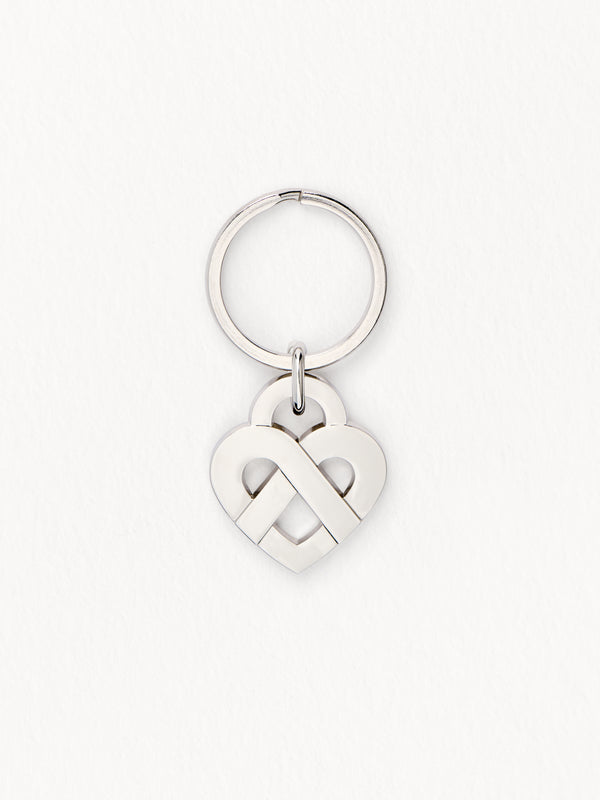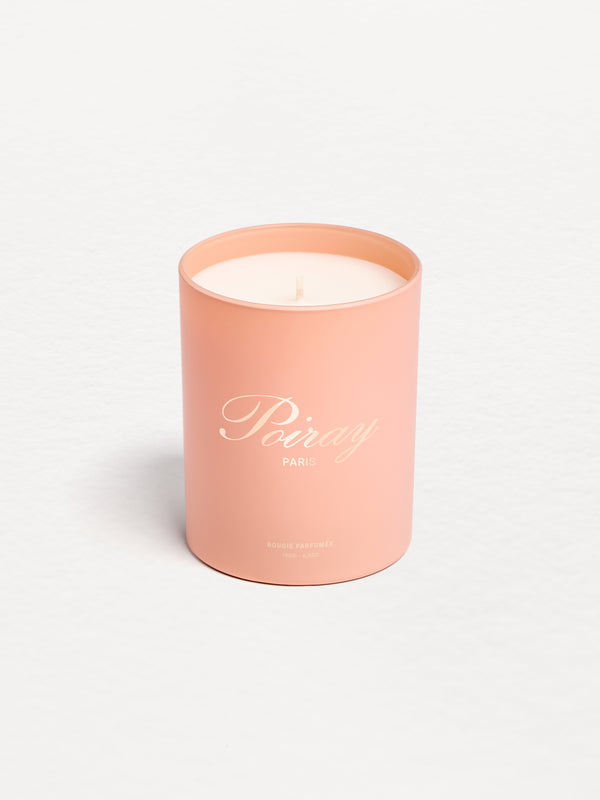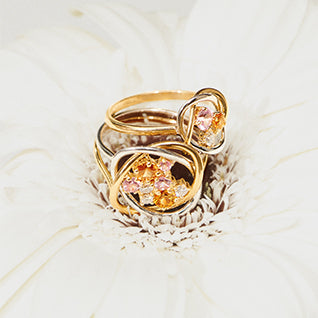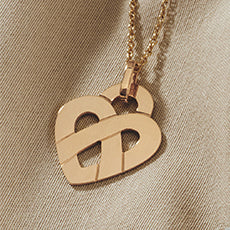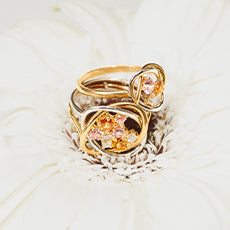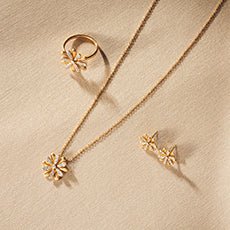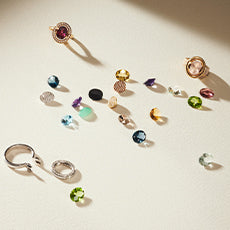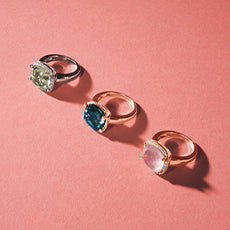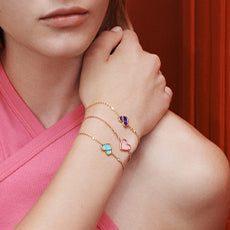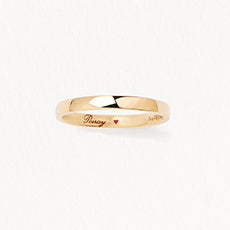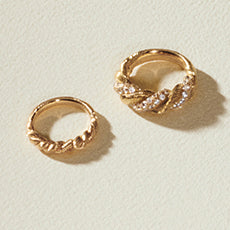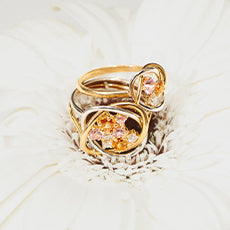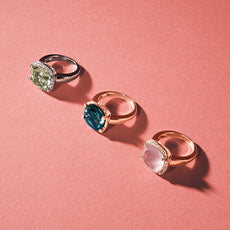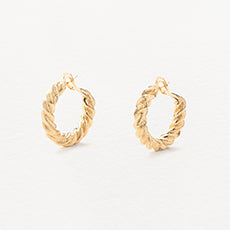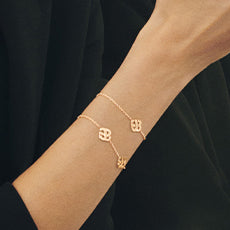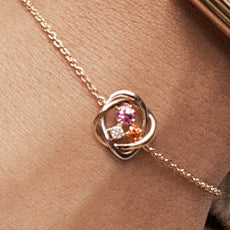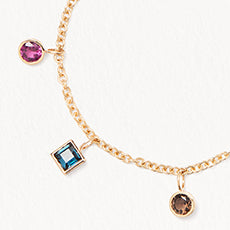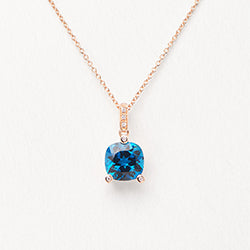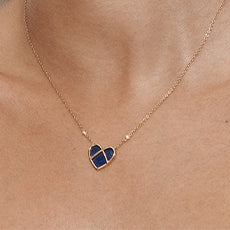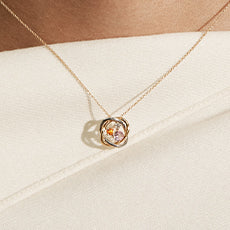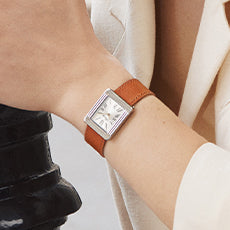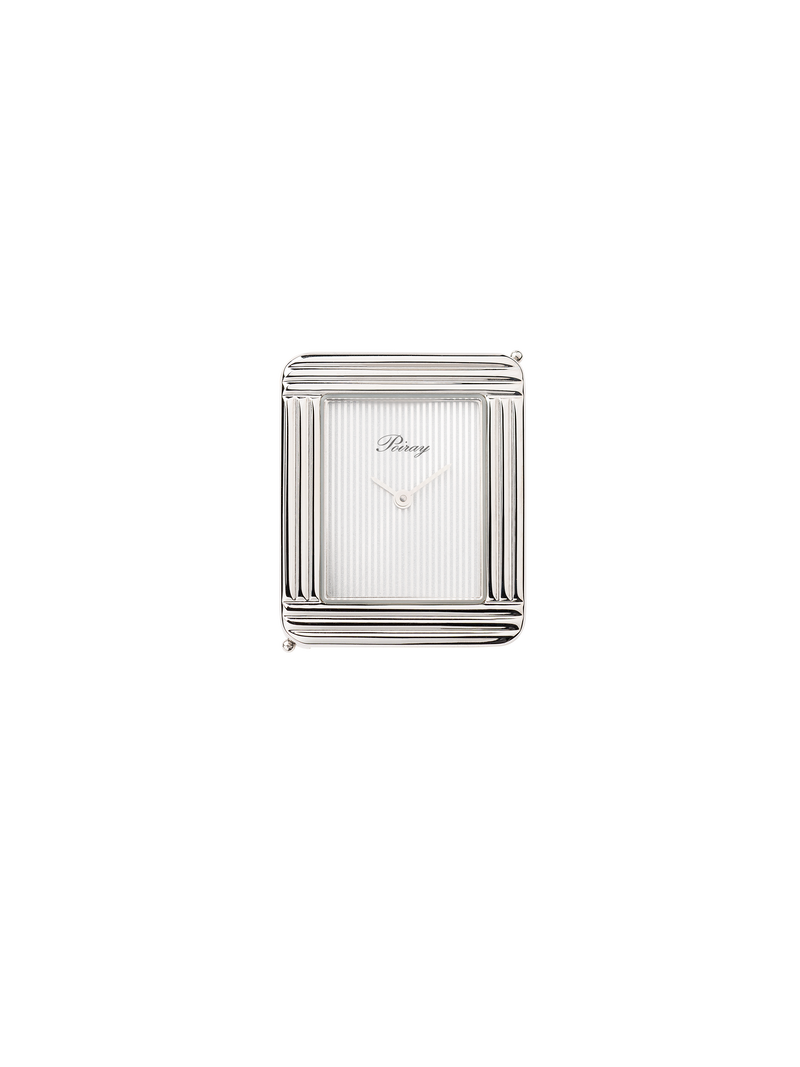The Diamond
The diamond, precious stone, is a transparent mineral composed of crystals of pure carbon. It is often colorless but can be naturally colored.
History: at the time of the pharaohs, the diamond symbolized the sun. He was considered the embodiment of the guide, strength and courage.
In India, more than 4,000 years ago, the diamond was the subject of trade where it was then used as an ornamental stone. Diamonds have always had a privileged place, and are considered stones with different virtues. The Indies were the first producers of diamonds, the mines there were rich and of exceptional quality.
Each diamond is unique and its value is determined by 4 characteristics: its weight, its purity, its color and its size.
Symbolic: the diamond is a symbol of purity and the brilliance of love. It is associated with perfection. In the Middle Ages, the diamond is the emblem of constancy, fidelity and love. Even today, after 60 years of marriage, we celebrate the diamond wedding anniversary.
The diamond brings harmony, love and complicity. For decades it has been a symbol of wealth and prosperity.
Origin: Africa, Asia and Oceania.
The Sapphire
Sapphire, a precious stone, is part of the corundum family. Although blue is the most well-known color of sapphire, it comes in a wide variety of colors.
History: sapphire is one of the hardest and most durable stones over time. Sapphire is highly coveted in the jewelry industry, for its precious appearance, its hardness but also for its wide variety of colors. Blue sapphire owes its color to the presence of titanium and iron in the stone. The yellow or green color is due to the presence of iron only, chromium confers a pink color, and vanadium a violet color.
For the ancient Egyptians and Romans, the sapphire was the stone of justice and truth.
Symbolic: the symbolism of the sapphire was for a long time peace, serenity, purity and wisdom. In love, it is the stone of fidelity.
Sapphire is also said to attract wealth and bring prosperity. A stone of plenitude and elevation, it encourages harmonious sensations.
The sapphire wedding represents 16 years of marriage.
Origin: Africa and Asia
The Ruby
Ruby, a precious stone, is part of the corundum family.
History: Ruby is an exceptionally beautiful and rare stone, it owes its color to the presence of chromium in the crystal. This gem has been known for millennia. Ruby is one of the most sought after stones in jewelry and is of great value.
The rarity and beauty of the ruby, brought to Europe by the Etruscans and the Greeks around 500 BC, have made it an extremely precious stone since Antiquity.
Symbolic: Ruby is a stone associated with joy, enthusiasm and loyalty. It is known to develop self-confidence and perseverance.
Ruby weddings represent 35 years of marriage.
Origin: Africa and Asia.
Morganite
Morganite is a natural stone of pink color which is part of the varieties of beryls.
History: morganite is a stone whose discovery dates back to the beginning of the 20th century, in California. Currently, the most illustrious morganite is on display at the British Museum in London. It comes from Madagascar, weighs around 600 carats, revealing a magnificent pink that many collectors appreciate.
Symbolic: Morganite promotes good thoughts and soothes tension. It also gives more wisdom and lucidity. It is the stone that helps to build the feeling of love and happiness that it works to strengthen and stimulate.
Origin: Africa.
Green Beryl
Green beryls belong to the group of silicates.
History: the power of Beryl was used during Antiquity to make magnifying glasses, then later, spectacle lenses.
Symbolic: beryl is recognized for its influence on emotions and feelings.
Origin: Africa and South America.
Yellow Beryl
Green beryls belong to the group of silicates.
History: Yellow beryl was discovered in Namibia at the beginning of the 20th century and was considered a "new stone" at the time. Its name comes from two Greek words meaning "gift of the sun".
Its yellow color is due to the iron that constitutes it.
Symbolic: beryl is recognized for its influence on emotions and feelings. Yellow beryl stimulates the mind and gives more willpower.
Origin: Africa and South America.
Amethyst
Amethyst, considered a fine stone, is a variety of purple quartz.
History: a noble and elegant stone, amethyst has been considered a noble and elegant stone since Antiquity.
It was used for decorative purposes by the Etruscans and Egyptians as an ornamental stone.
Symbolic: Amethyst is considered the stone of humility, sobriety and the stone of wisdom. It stimulates creativity, imagination and clarity and provides calm and relaxation.
Amethyst wedding represents 48 years of marriage.
Origin: Africa and South America.
Citrine
Citrine is a rare variety of quartz, with a yellow, orange or brownish hue.
History: for the Greeks, it was the stone of healing and wisdom. The Romans, on the other hand, used citrine to make jewelry.
It was also part of the "stones of merchants" because it had the reputation of helping to accumulate wealth.
With its warm and attractive color reminiscent of the radiance and heat of the sun, citrine is in great demand.
Symbolic: the main characteristics of citrine are the joy of living and abundance. This stone of wealth promotes the balance of energies as well as concentration. It is energizing and strongly develops creativity.
Citrine is also considered the stone of fortune, prosperity and success.
Origin: Africa and South America.
Rose Quartz
Rose quartz is part of the large family of oxides.
History: the first traces of the use of rose quartz date back to 7000 BC. It is present in all civilizations of the world, most often in the form of jewelry and carved figurines.
Symbolic: stone of love, rose quartz has always had a relationship with the heart. It brings calm, tenderness and softness.
Rose quartz is also considered the stone of sensitivity and empathy.
Origin: Africa and South America.
Smoky Quartz
Smoky quartz is a variety of macro-crystalline quartz.
History: in the 19th century, smoky quartz revealed a part of mystery that inspired many clairvoyants. Less limpid than rock crystal, this stone carefully guarded the predictions of the divination balls so that they remained secret from everyone's eyes.
Symbolic: smoky quartz improves lucidity and concentration. It also brings self-confidence and would make it possible to make the right decisions and to exercise discernment.
Origin: Africa and South America.
Prasiolite
Prasiolite is a fine stone also known as prase or green quartz.
History: already known in Antiquity, prasiolite was highly valued for its ornamental qualities. More recently, it experienced a resurgence in popularity during the Art Deco era where it was used extensively in decoration and in jewelry.
Symbolic: prasiolite strengthens self-confidence. Carrying a great energy of life, she develops a positive, expressive, radiant, joyful attitude.
Origin: Africa and South America.
Lemon Quartz
Lemon quartz belongs to the large quartz family.
History: lemon quartz is a natural quartz that has received a treatment to obtain its yellow color. Treatments by heating and irradiation on quartz have been practiced since the Middle Ages to embellish stones.
Symbolic: Quartz promotes clarity and neutrality and thus improves perception and understanding. A stone of purity and light, quartz amplifies our own light. It leads to self-knowledge and stimulates personal development.
Origin: Africa and South America.
Chalcedony
Chalcedony is a cryptocrystalline variety of quartz.
History: Blue Chalcedony is translucent with a matte sheen and ranges from very light blue to blue-green.
Discovered in Turkey in 4000 BC, the Babylonians and Assyrians used this stone for the design of tools.
Among the Romans, the chalcedony stone was worn for its beliefs: the contribution of speech and eloquence. For their part, the Egyptians also left beautiful objects made in this natural stone.
Symbolic: chalcedony is a very positive rock that brings softness and calm. It allows openness to others, listening and fraternity.
Blue chalcedony would strengthen self-confidence.
Origin: Africa and Asia.
Chrysoprase
Chrysoprase is a variety of green colored chalcedony.
History: the great civilizations of the past such as the Egyptians, the Greeks or the Romans intended chrysoprase for various uses including the manufacture of jewelry and decorative objects. Later, in the Middle Ages, chrysoprase had acquired the reputation of relieving certain ailments or detecting and remedying poisons.
Symbolic: it is known to have great energetic virtues. Chrysoprase helps with self-confidence, it would also bring softness and self-confidence.
Origin: Oceania.
Onyx
Onyx is a variety of agate.
History: in Rome, onyx was used for multiple purposes, ranging from interior decoration to the creation of seals because this stone had the property of not sticking to wax.
Symbolic: Onyx grants strength and support while bringing harmony and balance between body and mind. It is the stone of stability.
Origin: Asia and South America.
Rhodolite
Rhodolite garnet refers to a family of minerals belonging to the group of Silicates.
History: Garnet is a mineral that has been used since antiquity.
The great civilizations of the Mediterranean basin, from ancient Egypt to ancient Rome, via Greece, have always used red garnets in the manufacture of ornaments and delicate jewelry.
Symbolic: the garnet stone has many properties, bringing joy and strength to life, energy, courage, driving force and confidence. It is associated with the power of will, better self-confidence and success.
Origin: Africa, Asia and South America.
Pink Opal
Pink opal belongs to the quartz family.
History: Under the Roman Empire, pink opal was used as a talisman to bring joy and beauty.
Symbolic: the opal is the stone of romantic feelings par excellence. Symbol of tenderness and purity.
A stone of courage and wisdom, it stimulates reflection and soothes anger. She will be the perfect ally to face the challenges of life.
Origin: South America.
Peridot
Peridot is a fine stone belonging to the Olivine group.
History: Peridot was discovered in Egypt, approximately 1500 BC. For the Egyptians, peridot was part of the mystical world. Also, this stone was widely used in Greek jewelry and it was particularly possessed by the Ottoman rulers.
It was the Crusaders who brought the first crystals to Europe. It is for this reason that peridot was called for a long time "the stone of the knights".
Symbolic: Peridot is known to improve self-confidence. The energy contained in this stone gives it an important place in spirituality.
Symbolizing perfect happiness, peridot gives strength, promotes health and growth. It represents peace, balance and harmony.
Origin: North America and Africa.
Pink Tourmaline
Pink tourmaline is most often of the rubellite variety whose color oscillates between pink and red.
History: Tourmaline originated in Sri Lanka, where legend has it that this stone came from the sky and landed on Earth. During its descent, it would have crossed a rainbow which would have given it its great variations of hues.
Symbolic: soothing stone, it is energizing for the body and gives energy. It is claimed to promote peace and harmony. It allows you to exteriorize your feelings and is totally linked to the emotions of the heart.
Origin: Africa.
Topaz
Topaz is a mineral from the silicate family.
History: Topaz stone is a precious crystal known since antiquity. The Egyptians, Romans and Persians attributed powers to topazes and lent them virtues of invincibility.
Blue topaz is a fine stone with a color chart ranging from light blue (Sky Blue) to dark blue (Topaz Blue London).
Symbolic: Topaz is considered a stone that encourages reasoning, the creative spirit, ardor, opulence and success. In addition, it would facilitate dialogue and communication.
Often associated with people engaged in intellectual or artistic activity, it brings inspiration and clarity of mind.
Origin: Africa and Asia.
Moon Stone
Moonstone belongs to the family of silicates.
History: Due to the silvery/bluish ray that dances across the surface of the stone, it was believed in ancient India as well as Imperial Rome that moonstone was created by the rays of the moon.
Moonstone was often used at the time of the emergence of Art Nouveau for decorative objects.
Symbolic: moonstone dispels fears and anxieties. Moonstone is also a stone that brings balance and harmony.
It increases intuition and develops tolerance.
Origin: Asia.
Lapis Lazuli
Lapis lazuli is a rock containing silicates.
History: For more than 6500 years, lapis lazuli has been associated with the sacred, with kings and queens. In ancient times, the Egyptians carved and inlaid it into jewelry, furniture, caskets, daggers, shields and for palace ornamentation.
For the ancient civilizations of the Near East and Egypt, lapis lazuli was the true gemstone, more prized than gold itself.
Symbolic: lapis lazuli brings fullness and inner peace. It is a stone of balance, regulation, appeasement and repair.
Origin: Asia.
The Turquoise
Turquoise is a variety of alumina phosphate.
History: In America, turquoise was a sacred stone and was even used as currency. Among the Egyptians, it was rather decorative, although they believed in its supposed virtues to make immortal and bring luck.
During the Romantic period in Europe, turquoise took on a sentimental symbolism. When a lover had to leave far from his beloved, he offered a jewel set with turquoises which meant "Don't forget me".
Symbolic: turquoise makes you positive, it influences temperaments to make them more serene. It promotes friendship, social relations, exchange and creativity.
Origin: Asia.
